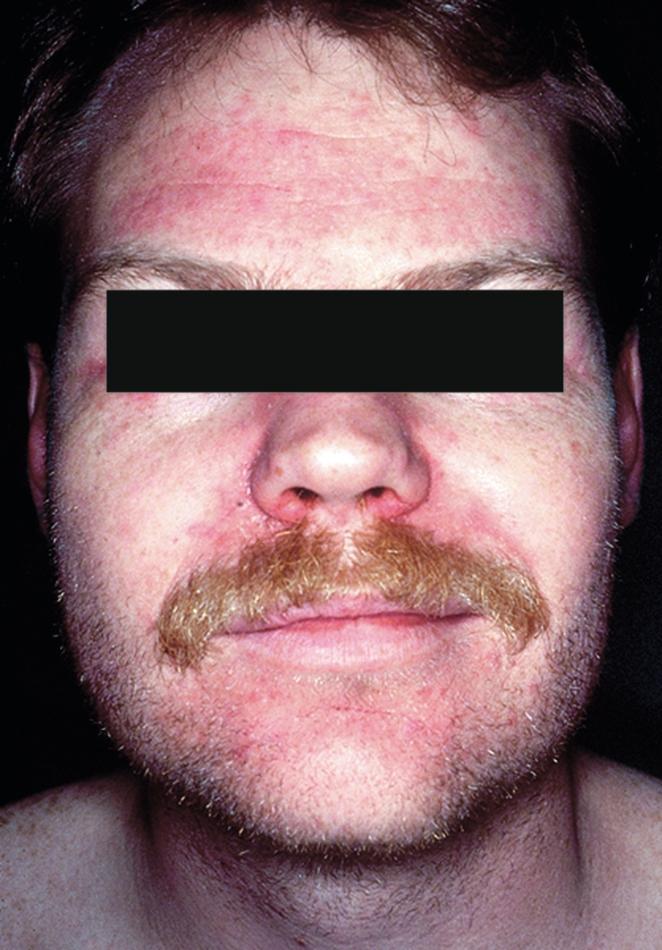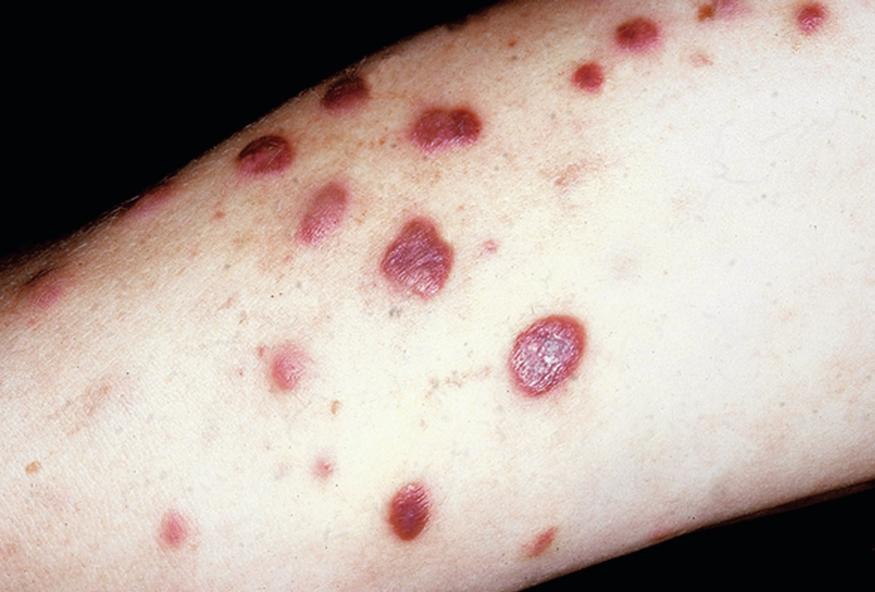Physical Address
304 North Cardinal St.
Dorchester Center, MA 02124
Dermatologic diseases are frequently encountered in HIV-infected patients. In one study of 100 serial outpatients, a 92% prevalence of skin disease was noted. Skin disease may also be the first manifestation of HIV disease and may suggest HIV infection because of increased severity of presentation, atypical clinical appearance, or increased resistance to treatment. In addition, mucocutaneous disease, such as an infection or neoplasm, may be the initial sign of a systemic process in an HIV-infected patient. Highly active antiretroviral therapy (HAART) was introduced in 1997 and has significantly decreased the occurrence and severity of many skin conditions associated with HIV infection, such as Kaposi’s sarcoma (KS), eosinophilic folliculitis, oral hairy leukoplakia, and molluscum contagiosum.
See Table 38.1 .
| Neoplastic diseases |
|
| Papulosquamous diseases |
|
| Miscellaneous diseases |
|
| Infectious diseases |
| Bacterial |
|
| Fungal |
|
| Viral |
|
| Arthropods |
|
⁎ Dover JS, Johnson RA. Cutaneous manifestations of human immunodeficiency virus infection: parts 1 and 2. Arch Dermatol. 1991;127:1383–1391, 1549–1558.James W, ed. AIDS: a ten-year perspective. Dermatol Clin. 1991;9:391–615.Costner M, Cockerell CJ. The changing spectrum of the cutaneous manifestations of HIV disease. Arch Dermatol. 1998;134:1290–1292.Kaushik SB, Cerci FB, Miracle J, et al. Chronic pruritus in HIV-positive patients in the southeastern United States: Its prevalence and effect on quality of life. J Am Acad Dermatol. 2014;70:659–664.Chapter 38, Cutaneous Manifestations of AIDS, is in the public domain.
Papulosquamous dermatoses are among the most commonly seen cutaneous manifestations of HIV infection, and these include seborrheic dermatitis ( Fig. 38.1 ) and xerosis. Other common dermatologic conditions include bacterial infections, such as Staphylococcus aureus skin infections. Fungal infections, such as mucocutaneous candidiasis (oropharyngeal and vulvovaginal) and dermatophytosis (tinea pedis, tinea cruris, tinea manuum, and onychomycosis), are also commonly encountered. Frequently seen viral infections include human papillomavirus (HPV) infections (condylomata acuminata, common and plantar warts), as well as infections with herpes simplex virus, varicella-zoster virus (VZV), molluscum contagiosum, and Epstein-Barr virus (oral hairy leukoplakia). The cutaneous manifestations of HAART including lipodystrophy and the dermatologic conditions related to the immune restoration syndrome (IRS) are commonly seen.

Yes. The earliest cutaneous sign of HIV infection is an exanthem consisting of discrete, erythematous macules and papules that usually measure 10 mm or less. They are located primarily over the trunk but also are seen on the palms and soles. These lesions may become hemorrhagic. The exanthem of acute HIV infection is not clinically or histologically specific. Mucosal changes described include oral, genital, and anal ulcers. These changes are associated with an acute febrile illness.
Staphylococcus aureus is the most common cutaneous bacterial pathogen in HIV disease. Cutaneous infections due to S. aureus most commonly present as a superficial folliculitis. Less common manifestations include impetigo, ecthyma, furunculosis, cellulitis, abscesses, and botryomycosis. In addition, S. aureus can secondarily infect underlying primary dermatoses such as eczema, scabies, herpetic ulcers, and KS or can colonize intravenous catheter sites. Staphylococcal colonization (carriage) of the nose and flexures (perineal, toe webspaces) is known to increase in HIV disease and may account for the increased incidence of cutaneous infections. As in the general population, infections with community-acquired methicillin-resistant S. aureus are becoming increasingly common.
Ahuja D, Albrecht H. HIV and community-acquired MRSA. AIDS Clin Care. 2009;21:21–23.
KS or, more specifically, epidemic KS is the most common cutaneous malignancy in HIV disease. In the Swiss HIV Cohort Study, the risk for KS continued to be at least 20-fold higher among HAART-treated individuals compared with that of the general population. Most cases occurred in homosexual or bisexual men with HIV disease. However, KS has also been reported in HIV-negative homosexual males. Human herpesvirus-8 is associated with epidemic as well as other types of KS.
Omland et al. reported that HIV-infected patients have an increased risk of cutaneous basal cell carcinoma (BCC) and squamous cell carcinoma (SCC) compared to a matched background cohort. The increased BCC risk was restricted to men who reported having sex with men as the route of HIV transmission. Nadir but not current CD4 count was associated with increased SCC risk.
A study by Asgari et al. comparing HIV-infected with HIV-uninfected individuals diagnosed with at least one nonmelanoma skin cancer (NMSC), defined as BCC or SCC, and excluding genital and oral BCCs and SCCs, showed that HIV-infected individuals were at increased risk of developing subsequent primary NMSC. The risk of subsequent development of SCC but not BCC was associated with recent higher viral loads and lower CD4 counts.
Clifford GM, Polesel J, Richenbach M, et al. Cancer risk in the Swiss HIV Cohort Study: associations with immunodeficiency, smoking, and highly active antiretroviral therapy. J Natl Cancer Inst. 2005;97:425–432.
Schwartz RA, Micali G, Nasca MR, et al. Kaposi sarcoma: a continuing conundrum. J Am Acad Dermatol. 2008;59:179–206.
Omland SH, Ahlstrom MG, Gerstoft J, et al. Risk of skin cancer in patients with HIV: a Danish nationwide cohort study. J Am Acad Dermatol. 2018;79:689–695.
Asgari MM, Ray GT, Quesenberry Jr CP, et al. Association of multiple primary skin cancers with human immunodeficiency virus infection, CD4 count, and viral load. JAMA Dermatol. 2017;153:892–896.
Epidemic KS has a widespread, symmetrical distribution of rapidly progressive macules, patches, nodules, plaques, and tumors. Common areas of involvement include the trunk, extremities, face, and oral cavity. Early lesions consist of erythematous macules, patches, or papules that may have a bruise-like halo. They enlarge at different rates and tend to be oval or elongated in shape, following the lines of skin cleavage. The color varies from pink to red, purple, or brown and can easily mimic purpura, hemangiomas, nevi, sarcoidosis, pityriasis rosea, secondary syphilis, lichen planus, BCC, and melanoma. The surface may become scaly, hyperkeratotic, ulcerated, or hemorrhagic.
Disfigurement and pain secondary to edema can occur, especially on the face, genitals, and lower extremities. Koebnerization, or formation of new lesions at sites of trauma, can be seen. Secondary bacterial infection can also occur. Lesions can be arranged in several known patterns, such as a follicular (clustered) pattern ( Fig. 38.2 ), pityriasis rosea–like pattern, or dermatomal pattern.

Compliance with prescribed HAART is important to improve the immune system and viral load. Therapy of localized disease may be with intralesional vinblastine, radiotherapy, liquid nitrogen cryotherapy, surgical excision, and topical alitretinoin. Treatment of more extensive disease includes α-interferon as well as single- or multiple-agent chemotherapy with vinblastine, vincristine, bleomycin, or liposomal doxorubicin.
Conant M. The International and North American Panretin Gel KS Study Groups: topical alitretinoin gel as treatment for cutaneous lesions of AIDS-related Kaposi's sarcoma: results of multicenter, double-blind, vehicle-controlled trials. Paper presented at: 6th Conference on Retroviruses and Opportunistic Infections; 1999; Chicago, IL.
Gbabe OF, Okwundu CI, Dedicoat M, et al. Treatment of severe or progressive Kaposi's sarcoma in HIV-infected adults. Cochrane Database Syst Rev. 2014;(8):CD003256.
Become a Clinical Tree membership for Full access and enjoy Unlimited articles
If you are a member. Log in here